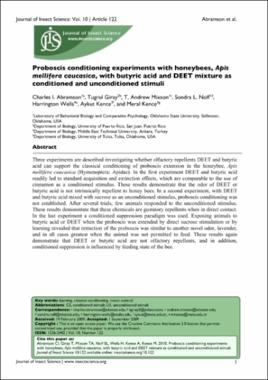| dc.contributor.author | Abramson, Charles I. | |
| dc.contributor.author | Giray, Tugrul | |
| dc.contributor.author | Mixson, T. Andrew | |
| dc.contributor.author | Nolf, Sondra L. | |
| dc.contributor.author | Wells, Harrington | |
| dc.contributor.author | Kence, Aykut | |
| dc.contributor.author | Kence, Meral | |
| dc.date.accessioned | 2015-10-16T20:47:23Z | |
| dc.date.available | 2015-10-16T20:47:23Z | |
| dc.date.issued | 2010 | |
| dc.identifier | okds_Abramson_JIS_2010 | |
| dc.identifier.citation | Abramson, C. I., Giray, T., Mixson, T. A., Nolf, S. L., Wells, H., Kence, A., & Kence, M. (2010). Proboscis conditioning experiments with honeybees, Apis mellifera caucasica, with butyric acid and DEET mixture as conditioned and unconditioned stimuli. Journal of Insect Science, 10, Article 122. https://doi.org/10.1673/031.010.12201 | |
| dc.identifier.uri | https://hdl.handle.net/11244/19713 | |
| dc.description.abstract | Three experiments are described investigating whether olfactory repellents DEET and butyric acid can support the classical conditioning of proboscis extension in the honeybee, Apis mellifera caucasica (Hymenoptera: Apidae). In the first experiment DEET and butyric acid readily led to standard acquisition and extinction effects, which are comparable to the use of cinnamon as a conditioned stimulus. These results demonstrate that the odor of DEET or butyric acid is not intrinsically repellent to honey bees. In a second experiment, with DEET and butyric acid mixed with sucrose as an unconditioned stimulus, proboscis conditioning was not established. After several trials, few animals responded to the unconditioned stimulus. These results demonstrate that these chemicals are gustatory repellents when in direct contact. In the last experiment a conditioned suppression paradigm was used. Exposing animals to butyric acid or DEET when the proboscis was extended by direct sucrose stimulation or by learning revealed that retraction of the proboscis was similar to another novel odor, lavender, and in all cases greatest when the animal was not permitted to feed. These results again demonstrate that DEET or butyric acid are not olfactory repellents, and in addition, conditioned suppression is influenced by feeding state of the bee. | |
| dc.format | application/pdf | |
| dc.language | en_US | |
| dc.publisher | Oxford University Press | |
| dc.rights | This material has been previously published. In the Oklahoma State University Library's institutional repository this version is made available through the open access principles and the terms of agreement/consent between the author(s) and the publisher. The permission policy on the use, reproduction or distribution of the material falls under fair use for educational, scholarship, and research purposes. Contact Digital Resources and Discovery Services at lib-dls@okstate.edu or 405-744-9161 for further information. | |
| dc.title | Proboscis conditioning experiments with honeybees, Apis mellifera caucasica, with butyric acid and DEET mixture as conditioned and unconditioned stimuli | |
| osu.filename | okds_Abramson_JIS_2010.pdf | |
| dc.description.peerreview | Peer reviewed | |
| dc.identifier.doi | 10.1673/031.010.12201 | |
| dc.description.department | Psychology | |
| dc.description.department | Zoology | |
| dc.type.genre | Article | |
| dc.type.material | Text | |
| dc.subject.keywords | learning | |
| dc.subject.keywords | classical conditioning | |
| dc.subject.keywords | insect control | |
